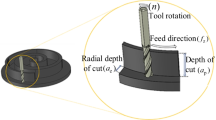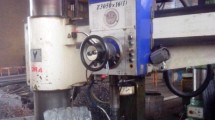Abstract
The appearance of the servo press in recent years has given manufacturers more stamping models to choose from. In sheet metal drawing, the servo motion curve is key to forming success. In this paper, we proposed the method by applying a fuzzy Taguchi method to achieve the robust multi-objective optimization of the servo press pulsating curve for rectangular cup drawing. We first used the stamping analysis software to perform the simulation analysis with various pulsating curve parameters, including press-in distance, press-in velocity, lifting distance, and lifting velocity. We conducted single-objective optimization using Taguchi’s smaller-the-better formula with thinning ratio, punch force, and drawing time as the quality objectives. Also, the influence of the four process parameters on the quality objectives and their mathematical relationships are confirmed using analysis of variance (ANOVA) and multiple regression analysis. Next, we used fuzzy logic inference to calculate the measuring index of the multiple performance characteristics index (MPCI) and then conducted an optimization analysis using Taguchi’s larger-the-better formula. From S/N ratios and the ANOVA results, the best combination of parameters and the contributions of each parameter was found. Finally, we verified the drawing process’s multi-objective servo motion curve parameters.















Similar content being viewed by others
Data availability
The datasets generated during and/or analyzed during the current study are available from the corresponding author on reasonable request.
References
Osakada K, Mori K, Altan T, Groche P (2011) Mechanical servo press technology for metal forming. CIRP Ann 60:651–672
Maeno T, Osakada K, Mori K (2011) Reduction of friction in compression of plates by load pulsation. Int J Mach Tools Manuf 51:612–617
Halicioglu R, Dulger LC, Bozdana AT (2017) Modeling, design, and implementation of a servo press for metal-forming application. J Adv Manuf Technol 91:2689–2700
Matsumoto R, Jeon J, Utsunomiya H (2013) Shape accuracy in the forming of deep holes with retreat and advance pulse ram motion on a servo press. J Mater Process Technol 213:770–778
Maeno T, Mori K, Hori A (2014) Application of load pulsation using servo press to plate forging of stainless steel parts. J Mater Process Technol 214:1379–1387
Kaya S (2016) Nonisothermal warm deep drawing of SS304: FE modeling and experiments using servo press. J Adv Manuf Technol 83:1047–1056
Song Q, Guo B, Li J (2013) Drawing motion profile planning and optimizing for heavy servo press. J Adv Manuf Technol 69:2819–2831
Mostafapour A, Akbari A, Nakhaei MR (2017) Application of response surface methodology for optimization of pulsating blank holder parameters in deep drawing process of Al 1050 rectangular parts. J Adv Manuf Technol 91:731–737
Olguner S, Bozdana AT (2017) Influence of press ram pulsation on deep drawability of dual phase steel sheet. Acta Phys Pol A 132:742–745
Lin BT, Yang CY (2017) Applying the Taguchi method to determine the influences of a microridge punch design on the deep drawing. J Adv Manuf Technol 88:2109–2119
Badgujar TY, Wani VP (2018) Stamping process parameter optimization with multiple regression analysis approach. Mater Today: Proceedings 5:4498–4507
Zadeh L (1965) Fuzzy sets. Int J Inf Control 8:338–353
Tzeng YF, Chen FC (2007) Multi-objective optimisation of highspeed electrical discharge machining process using a Taguchi fuzzy-based approach. Mater Des 28:1159–1168
Palanikumar K, Karunamoorthy L, Karthikeyan R, Latha A (2006) Optimization of machining parameters in Turning GFRP composites using a carbide (K10) tool based on the Taguchi method with fuzzy logics. Met Mater Int 12:483–491
Hsien KH, Huang SC (2013) Use of the fuzzy-based Taguchi method for the optimization design of an ultrathin centrifugal fan. Appl Mech Mater 284–287:2946–2949
Hwang CC, Chang CM, Liu CT (2013) Fuzzy-based Taguchi method for multiobjective design of PM motors. IEEE Trans Magn 49:2153–2156
IShivakoti I, Kibria G, Pradhan BB, Sharma A (2020) Experimental investigation and fuzzy-based modeling of micro-EDM process parameters. Adv Green Energy Environ pp 665–683
Moganapriya C, Rajasekar R, Sathish Kumar P, Mohanraj T, Gobinath VK, Saravanakumar J (2021) Achieving machining effectiveness for AISI 1015 structural steel through coated inserts and grey-fuzzy coupled Taguchi optimization approach. Struct Multidiscipl Optim 63:1169–1186
Tsui KL (1992) An overview of Taguchi method and newly developed statistical methods for robust design. IIE Trans 24
Mizuno ED, Li ZT (2008) Stress analysis of rectangular cup drawing. J Mater Process Technol 205:469–476
Ross TJ (1995) Fuzzy logic with engineering applications. McGraw-Hill, NY
Sunil S, Kapoor R (2020) Effect of strain rate on the formation of strain-induced martensite in AISI 304L stainless steel. Metall Mater Trans A 51:5667–5676
Cios G, Tokarski T, Żywczak A, Dziurka R, Stępień M, Gondek Ł, Marciszko M, Pawłowski B, Wieczerzak K, Bała P (2017) The investigation of strain-induced martensite reverse transformation in AISI 304 austenitic stainless steel. Metall Mater Trans A 48:4999–5008
Acharya S, Moitra A, Bysakh S, Nanibabu M, Krishanan SA, Mukhopadhyay CK, Rajkumar KV, Sasikala G, Mukhopadhyay A, Mondal DK, Ghosh KS, Jha BB, Muraleedharana K (2019) Effect of high strain rate deformation on the properties of SS304L and SS316LN alloys. Mech Mater 136:103073
Acknowledgements
This work was financially supported by the Frontier Mould and Die Research and Development Center from The Featured Areas Research Center Program within the framework of the Higher Education Sprout Project by the Ministry of Education (MOE) in Taiwan.
Funding
This work was financially supported by the Frontier Mould and Die Research and Development Center from The Featured Areas Research Center Program within the framework of the Higher Education Sprout Project by the Ministry of Education (MOE) in Taiwan.
Author information
Authors and Affiliations
Contributions
The authors’ contributions are as follows: all authors conceived and designed the study; Kuo-Wang Liu performed the theoretical deduction, performed the experiments and the finite element simulations, performed the process optimization and analysis; Chun-Chih Kuo contributed to the interpretation of the results; Chun-Chih Kuo and Kuo-Wang Liu contributed actively in writing the manuscript; all authors provided critical feedback and helped shape the research, analysis, and manuscript.
Corresponding author
Ethics declarations
Ethical approval
The authors claim that none of the contents in this manuscript has been published or considered for publication elsewhere. Besides, the research contents of the article do not violate ethics.
Consent to participate
This manuscript does not involve human or animal participation or data, therefore consent to participate is not applicable.
Consent to publish
This manuscript does not contain data from any individual person; therefore, consent to publish is not applicable.
Conflict of interest
The authors declare no competing interests.
Additional information
Publisher's Note
Springer Nature remains neutral with regard to jurisdictional claims in published maps and institutional affiliations.
Rights and permissions
Springer Nature or its licensor holds exclusive rights to this article under a publishing agreement with the author(s) or other rightsholder(s); author self-archiving of the accepted manuscript version of this article is solely governed by the terms of such publishing agreement and applicable law.
About this article
Cite this article
Liu, KW., Kuo, CC. Application of the fuzzy-based Taguchi method for servo stamping curve. Int J Adv Manuf Technol 121, 7325–7339 (2022). https://doi.org/10.1007/s00170-022-09820-x
Received:
Accepted:
Published:
Issue Date:
DOI: https://doi.org/10.1007/s00170-022-09820-x




